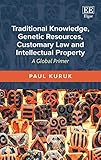Traditional Knowledge, Genetic Resources, Customary Law and Intellectual Property : A Global Primer
Publisher: Northampton : Edward Elgar Publishing, 2020Description: pages cmContent type:- text
- unmediated
- volume
- 9781785368479
- 346.048 KUR
| Item type | Current library | Collection | Shelving location | Call number | Status | Date due | Barcode |
|---|---|---|---|---|---|---|---|
 BOOKs
BOOKs
|
National Law School | Reference | REFERENCE SECTION | 346.048 KUR (Browse shelf(Opens below)) | Available | 38140 |
Browsing National Law School shelves, Shelving location: REFERENCE SECTION , Collection: Reference Close shelf browser (Hides shelf browser)

|

|

|

|

|

|

|
||
| 346.022 TRE Frustration and Force Majeure | 346.022 ZEL Damages under the convention on contracts for the international sale of goods / | 346.046 ODO Legal Rights for Rivers : | 346.048 KUR Traditional Knowledge, Genetic Resources, Customary Law and Intellectual Property : | 346.065 POL Research Handbook on Corporate Purpose and Personhood / | 346.06646 HUD The law on financial derivatives / | 346.0666 CHI The law of majority shareholder power : |
Contents: INTRODUCTION PART I NATURE OF SUBJECT MATTER AND COMMUNITY EXPECTATIONS; 1. Terminology;
2. Exploitation of Traditional Knowledge to Indigenous and Local Communities; 3. Traditional Knowledge and Intellectual Property Rights PART II INTERNATIONAL INITIATIVES ; 4. International Intellectual Property Law ; 5. Folklore, Cultural Heritage and Traditional Knowledge ; 6. Genetic Resources and Biodiversity Conservation ; 7. Human Rights and Indigenous Peoples PART III REGIONAL AND NATIONAL MEASURES ; 8. Emerging Trends of Protection in Africa ; 9. Perspectives from the United States
; 10. Views from Oceania ; 11. Developments in Other Regions PART IV IN SEARCH OF SOLUTIONS ; 12. Complementary Laws and Policies ; 13. The Customary Law Option ; 14. Preventing Misappropriation: The Disclosure Requirement ; 15. Reciprocity and Mutual Recognition Agreements Index
"This global primer surveys international initiatives on traditional knowledge, folklore, cultural heritage and genetic resources, and describes in a comprehensive manner regional and national principles of protection in Asia, Europe, Africa, Oceania, the Middle East, the United States and the Americas. The most innovative parts of the book discuss three key approaches. First, the book highlights the relevance of customary law, describes how it is recognized and applied in legal systems and assesses its effectiveness as an enforcement mechanism. Second, through selected cases, the book illustrates the problem of biopiracy to which the disclosure requirement has been proposed as a policy response. It traces the origins of the disclosure requirement to instruments developed jointly by WIPO and UNESCO. Third, the book proposes a novel approach to protecting traditional knowledge premised on the principle of reciprocity and the use of mutual recognition agreements (MRAs) and assesses the scope of such MRAs Libraries and universities will find this work is an invaluable resource for scholars and researchers. The material will also be important for government officials and organizations developing policy. Furthermore, the information available in these pages can empower indigenous peoples and local communities looking to promote awareness and protect traditional knowledge"-- Provided by publisher.

There are no comments on this title.